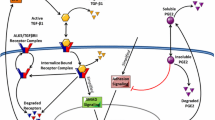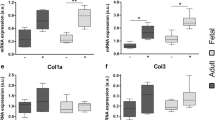Abstract
Transglutaminase (TGase) has been reported to stabilize tissue inflammation via the mediation of the polymerization of extracellular matrix proteins. A set of cytokines has been implicated in wound healing processes in the dermis. This study was undertaken in order to evaluate the effects of these cytokines on the expression of TGase 2 in human dermal fibroblasts (hDFs), in that TGase 2 is known to be the principal TGase in the dermis. In Western blot analysis, TGF-β1 (1 ng/ml) treatment was found to steadily up-regulate TGase 2 expression for up to 7 days. However, such increases were not observed when the cells were treated with IL-1β, IL-2, and TNF-α. In the enzyme assay, total TGase activities were closely related to the levels of TGase 2 expression. TGase 2 mRNA expression was up-regulated as the result of TGF-β treatment in competitive RT-PCR. In the denatured SDS-PAGE, TGF-β1 treatment resulted in marked induction of an approximately 220 kDa protein, which was revealed to be a fibronectin (FN) via western immunoblotting with an anti-FN antibody. Next, when the hDFs were treated with TGF-β1 (1 ng/ml), FN expression was induced beginning at the third day after treatment. The immunoprecipitants generated by anti-FN antibody were positive for the anti-TGase 2 antibody, and the immune complexes were identified at molecular weights of 92 kDa. Collectively, TGF-β1 stimulates the polymerization of FN via the action of TGase 2, which is supposed to to be an important mechanism in the stabilization of the inflammatory dermis.






Similar content being viewed by others
References
Greenberg CS, Birckbichler PJ, Rice RH (1991) Transglutaminases: multifunctional cross-linking enzymes that stabilize tissues. FASEB J 5:3071–3077
Balklava Z, Verderio E, Collighan R, Gross S, Adams J, Griffin M (2002) Analysis of tissue transglutaminase function in the migration of Swiss 3T3 fibroblasts: the active-state conformation of the enzyme does not affect cell motility but is important for its secretion. J Biol Chem 277:16567–16575
Radek JT, Jeong JM, Murthy SN, Ingham KC, Lorand L (1993) Affinity of human erythrocyte transglutaminase for a 42-kDa gelatin-binding fragment of human plasma fibronectin. Proc Natl Acad Sci USA 90:3152–3156
Akimov SS, Belkin AM (2001) Cell-surface transglutaminase promotes fibronectin assembly via interaction with the gelatin-binding domain of fibronectin: a role in TGF β dependent matrix deposition. J Cell Sci 114:2989–3000
Johnson TS, Knight CR, cl-Alaoui S, Mian S, Rees RC, Gentile V, Davies PJ, Griffin M (1994) Transfection of tissue transglutaminase into a highly malignant hamster fibrosarcoma leads to a reduced incidence of primary tumour growth. Oncogene 9:2935–2942
Van Groningen JJ, Klink SL, Bloemers HP, Swart GW (1995) Expression of tissue-type transglutaminase correlates positivity with metastatic properties of human melanoma cell lines. Int J Cancer 60:383–387
Kligman LH, Yang S, Schwartz E (1999) Steady-state mRNA levels of interleukin-1, integrins, cJun, and cFos in hairless mouse skin during short-term chronic UV exposure and the effect of topical tretinoin. Photodermatol Photoimmunol Photomed 15:198–204
Sottile J, Hocking DC (2002) Fibronectin polymerization regulates the composition and stability of extracellular matrix fibrils and cell-matrix adhesions. Mol Biol Cell 13:3546–3559
Shen J, Bao S, Reeve VE (1999) Modulation of IL-10, IL-12, and IFN-γ in the epidermis of hairless mice by UVA (320–400 nm) and UVB (280–320 nm) radiation. J Invest Dermatol 113:1059–1064
Fukuda K, Kojiro M, Chiu JF (1993) Induction of apoptosis by transforming growth factor-β1 in the rat hepatoma cell line McA-RH7777: a possible association with tissue transglutaminase expression. Hepatology 18:945–953
Ritter SJ, Davies PJ (1998) Identification of a transforming growth factor-β/bone morphogenetic protein 4 (TGF-β/BMP4) response element within the mouse tissue transglutaminase gene promoter. J Biol Chem 273:12798–12806
Welge-Lussen U, May CA, Lutjen-Drecoll E (2000) Induction of tissue transglutaminase in the trabecular meshwork by TGF-β1 and TGF-β2. Invest Ophthalmol Vis Sci 42:2229–2238
George MD, Vollberg TM, Floyd EE, Stein JP, Jetten AM (1990) Regulation of transglutaminase type II by transforming growth factor-β1 in normal and transformed human epidermal keratinocytes. J Biol Chem 265:11098–11104
Ritter SJ, Davies PA (1998) Identification of a transforming growth factor-β1/bone morphogenetic protein 4 (TGF-β1/BMP4) response element within the mouse tissue transglutaminase gene promoter. J Biol Chem 273:12798–12806
Raghow R, Postlethwaite AE, Keski-Oja J, Moses HL, Kang AH (1987) Transforming growth factor-β increases steady state levels of type I procollagen and fibronectin messenger RNAs posttranscriptionally in cultured human dermal fibroblasts. J Clin Invest 79:1285–1288
Varga J, Olsen A, Herhal J, Constantine G, Rosenbloom J, Jimenez SA (1990) Interferon-γ reverses the stimulation of collagen but not fibronectin gene expression by transforming growth factor-β in normal human fibroblasts. Eur J Clin Invest 20:487–493
LeMosy EK, Erickson HP, Beyer WF Jr, Radek JT, Jeong JM, Murthy SN, Lorand L (1992) Visualization of purified fibronectin-transglutaminase complexes. J Biol Chem 267:7880–7885
Fesus L, Metsis ML, Muszbek L, Koteliansky VE (1986) Transglutaminase-sensitive glutamine residues of human plasma fibronectin revealed by studying its proteolytic fragments. Eur J Biochem 154:371–374
Nedelman J, Heagerty P, Lawrence F (1992) Quantitative PCR with internal controls. Comput Appl Biosci 8:65–70
Bouaboula M, Legoux P, Pessegue B, Delpech B, Dumont X, Piechaczyk M, Casellas P, Shire D (1992) Standardization of mRNA titration using a polymerase chain reaction method involving co-amplification with a multispecific internal control. J Biol Chem 267:21830–21838
Chung SI, Folk JE (1972) Kinetic studies with transglutaminases. The human blood enzymes activated coagulation factor 13 and the guinea pig hair follicle enzyme. J Biol Chem 247:2798–2807
Yin L, Morita A, Tsuji T (2003) The crucial role of TGF-β in the age-related alterations induced by ultraviolet A irradiation. J Invest Dermatol 120:703–705
Chainiaux F, Remacle J, Toussaint O (2002) Exposure of human skin diploid fibroblasts to repeated subcytotoxic doses of ultraviolet-B induces the overexpression of transforming growth factor-β1 mRNA. Ann NY Acad Sci 973:44–48
Quan T, He T, Voorhees JJ, Fisher GJ (2002) Ultraviolet irradiation blocks cellular responses to transforming growth factor-β by down-regulating its type-II receptor and inducing Smad. J Biol Chem 276:26349–26356
Haroon ZA, Hettasch JM, Lai TS, Dewhirst MW, Greenberg CS (1999) Tissue transglutaminase is expressed, active, and directly involved in rat dermal wound healing and angiogenesis. FASEB J 13:1787–1795
Upchurch HF, Conway E, Patterson MK Jr, Maxwell MD (1991) Localization of cellular transglutaminase on the extracellular matrix after wounding: characteristics of the matrix bound enzyme. J Cell Physiol 149:375–382
Nicholas B, Smethurst P, Verderio E, Jones R, Griffin M (2003) Cross-linking of cellular proteins by tissue transglutaminase during necrotic cell death: a mechanism for maintaining tissue integrity. Biochem J 371:413–422
Wan XH, Lee EH, Koh HJ, Song J, Kim EK, Kim CY, Lee JB, Kim SY, Yao K, Lee JH (2002) Enhanced expression of transglutaminase 2 in anterior polar cataracts and its induction by TGF-β in vitro. Br J Ophthalmol 86:1293–1298
Fukuda K, Kojiro M, Chiu JK (1994) Differential regulation of tissue transglutaminase in rat hepatoma cell lines McA-RH7777 and McA-RH8994: relation to growth rate and cell death. J Cell Biochem 54:67–77
Kojima S, Nara K, Rifkin DB (1993) Requirement of transglutaminase in the activation of latent transforming growth factor-β in bovine endothelial cells. J Cell Biol 121:439–448
Massague L (2002) TGF-β signal transduction. Annu Rev Biochem 67:753–791
Wrana JL, Carcamo J, Attisano L, Cheifetz S, Zentella A, Lopez-Casillas F, Massague J (1992) The type II TGF-β receptor signals diverse responses in cooperation with the type I receptor. Cold Spring Harb Symp Quant Biol 57:81–86
Falanga V, Tiegs SL, Alstadt SP, Roberts AB, Sporn MB (1987) Transforming growth factor β: selective increase in glycosaminoglycan synthesis by cultures of fibroblasts from patients with progressive systemic sclerosis. J Invest Dermatol 89:100–104
Clark RA, Winn HJ, Dvorak HF, Colvin RB (1983) Fibronectin beneath reepithelializing epidermis in vivo: sources and significance. J Invest Dermatol 80 (Suppl):26s–30s
Martinez J, Chalupowicz DG, Roush RK, Sheth A, Barsigian C (1994) Transglutaminase-mediated processing of fibronectin by endothelial cell monolayers. Biochemistry 33:2538–2545
Kurkinen M, Vaheri A, Roberts PJ, Stenman S (1980) Sequential appearance of fibronectin and collagen in experimental granulation tissue. Lab Invest 43:47–51
Turner PM, Lorand L (1989) Complexation of fibronectin and tissue transglutaminase. Biochemistry 28:628–635
Acknowledgements
This work was supported by grants to Dr. Lee from the Chonnam National University Hospital Research and the Wuam Foundation Academy of Science sponsored by Yanssen Korea Ltd. This paper is dedicated to late Dr. Peter Steinert, who was a great scientist with warm humanity.
Author information
Authors and Affiliations
Corresponding author
Rights and permissions
About this article
Cite this article
Quan, G., Choi, JY., Lee, DS. et al. TGF-β1 up-regulates transglutaminase two and fibronectin in dermal fibroblasts: a possible mechanism for the stabilization of tissue inflammation. Arch Dermatol Res 297, 84–90 (2005). https://doi.org/10.1007/s00403-005-0582-8
Received:
Revised:
Accepted:
Published:
Issue Date:
DOI: https://doi.org/10.1007/s00403-005-0582-8




